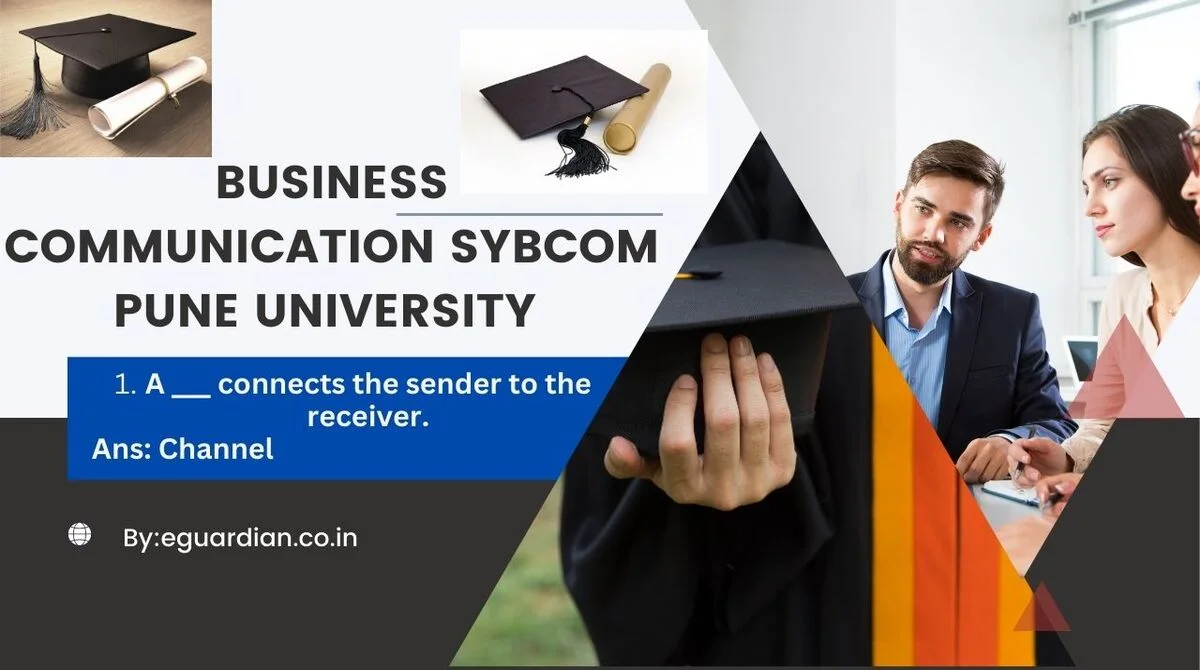Business Communication SYBCOM Pune University MCQ with Answers for the preparation of competitive and academic examinations. These MCQs are also helpful for other various Universities.

Business Communication SYBCOM Pune University MCQ
1. Communication ___ people who believe in a common cause.
(a) Leads
(b) Links
(c) Helps
(d) establishes
Answer: (b)
2. An organization can function as a ___ only by communicating effectively with the environment.
(a) Group
(b) System
(c) channel
(d) team
Answer: (b)
3. ___ is an exchange of facts, ideas, opinions, or emotions by two or more persons.
(a) Communication
(b) Combination
(c) conversation
(d) Connection
Answer: (a)
4. A ___ connects the sender to the receiver.
(a) Channel
(b) Noise
(c) communication
(d) Feedback
Answer: (a)
5. The primary goal of communication is to ___
(a) to create barriers
(b) to create noise
(c) to effect a change
(d) none of them
Answer: (c)
6. The ___ of the correct channel depends on the situation under which the communication takes place
(a) Chance
(b) Choice
(c) change
(d) channel
Answer: (c)
7. A message can be misinterpreted because of ___
(a) Bans
(b) Receiver
(c) barriers
(d) sender
Answer: (b)
8. Communication through ___ and ___ is called Verbal Communication.
(a) Written material and gestures
(b) Gestures and spoken words
(c) Spoken words and written material
(d) Body language and gestures
Answer: (c)
9. ___ enables any organization to achieve its set goal.
(a) Conversation
(b) Effective communication
(c) condescension
(d) combination
Answer: (c)
10. ___ is the study of touches as nonverbal communication
(a) haptics
(b) Body language
(c) gestures
(d) prosody
Answer: (a)
11. ___ is also called ‘critical listening’ because we make judgments about what the other person is saying.
(a) evaluative listening
(b) appreciative listening
(c) empathetic listening
(d) dialogic listening
Answer: (a)
12. ___ is the most basic type of listening
(a) Comprehension
(b) Discriminative
(c) evaluative
(d) dialogic
Answer: (c)
13. ___ is done when you need to continue learning and studying so that you develop your own thinking and skills
(a) Professional reading
(b)Action reading
(c)extensive reading
(d) intensive reading
Answer: (a)
14. When we read aloud our concentration is divided between ___ and ___
(a) Writing and speaking
(b) Speaking and reading
(c) reading and writing
(d) listening and writing
Answer: (b)
15. The fourth step in the SQ3R technique of reading is ___
(a) Recall
(b) Review
(c) survey
(d) reading
Answer: (a)
16. All calls should be answered within ___ rings
(a) 2
(b) 4
(c) 3
(d) 5
Answer: (d)
17. The full form of the abbreviation CEO is
(a) Chief Electricity Officer
(b) Chief Executive Officer
(c) Common Executive Officer
(d) Chief Executive Official
Answer: (b)
18. Communication which occurs through official language is ___
(a) Informal communication
(b) Formal communication
(c) Internal communication
(d) External communication
Answer: (c)
19. Agenda is also called ___
(a) Thought of the day
(b) Task of the day
(c) Orders of the day
(d) Terms of the day
Answer: (b)
20. ___ is an announcement sheet that is sent to a specific group of people.
(a) Notice
(b) Memo
(c) Circular
(d) Letter
Answer: (b)
21. We communicate orally in two ways: ___ and ___.
(a) telephonic conversation; nonverbal communication
(b) verbal communication; face-to-face communication
(c) face-to-face communication; telephonic conversation
(d) verbal communication; nonverbal communication
Answer: (c)
22. ___ and ___as visual aids should contain the minimum information necessary.
(a) Flip charts; slides
(b) Powerpoint slides; overhead projector
(c) Video and film
(d) Overhead projector; slides
Answer: (d)
23. ___ and___ are two of the most common types of words used to improve cohesion
(a) Coordinating and subordinating conjunctions
(b) Subject and predicate
(c) Transitions and subordinating conjunctions
(d) Prepositions and conjunctions
Answer: (d)
24. At each stage in the process of communication, there is a possibility of interference which may hinder the process. Such interference is known as ___.
(a) sender
(b) receiver
(c) barrier
(d) none of them
Answer: (c)
25. While writing a business letter it is important that your letter be ___ and ___
(a) concise, direct
(b) long, indirect
(c) short, simple
(d) loose, complicated
Answer: (a)
26. If staff in an organization is suspected of major misconduct, the organization may issue a ___ which will mention the ___ against the staff concerned and ask for a written explanation
a. notice, information
b. memo, praise
c. show cause notice, allegations
d. letter, punishment
Answer: (c)
27. A ___ is essentially a statement of facts of a situation, project or process or test and it should be supported by ___
a. notice, proof
b. technical report, evidence
c. memo, information
d. business letter, documents
Answer: (b)
28. ___ and ____ act as barriers to communication.
a. semantic distortions, lack of planning
b. sender, receiver
c. channel, message
d. feedback, sender
Answer: (a)
29. Unclarified assumptions in communication can lead to ___ and ___
a. premature evaluation, poor listening
b. information overload, selective perception
c. lack of planning, physical barriers
d. confusions, misunderstanding
Answer: (d)
30. Non-verbal communication consists of ___ and___.
a. eye gazing, sounds
b. gestures, words
c. tone, body language
d. words, body language
Answer: (c)
31. Find out errors: –
Besides being good at tennis, he is also an excellent player of golf.
a. good – better, being – been
b. beside – besides, in – at
c. excellent – intelligent, beside – besides
d. in – at, being – been
Answer: (b)
32. Find out errors: Neither John nor Wendy want to go dance
a. dance- dancing; want- wants
b. neither- either; nor- or
c. go- going; want- want
d. dance- dancing; neither- either
Answer: (a)
33. While using Overhead Projector, you can reveal information line by line using an ___ sheet to cover the ___
a. opaque; flipchart
b. translucent; transparency
c. transparent; slide
d. opaque; transparency
Answer: (d)
34. The semantic markers used to express time relationship are:
a. next; after
b. after; consequently
c. hence; to summarize
d. while; because
Answer: (a)
35. In letter writing, ___ indicates to the reader of the letter what the ___ is about.
a. salutation; letter
b. subject; notice
c. body/ content; memo
d. subject; letter
Answer: (a)
36. The semantic markers used to express cause and effect relationship between one idea and another are:
a. in other words; because
b. since; hence
c. then; therefore
d. consequently; while
Answer: (d)
37. A resume needs conceptualization of your ___ and ___ all into one document.
a. objectives; experiences
b. projects; skills
c. accomplishments; experiences
d. skills; aims
Answer: (c)
38. A press story is ___ news story, written in ___ person that seeks to demonstrate to an editor or reporter the newsworthiness of a particular person, event, service, or product.
(a) false; first
(b) pseudo; third
(c) real; second
(d) original; third
Answer: (b)
39. What do these proofreading symbols stand for:
a. insert a comma; apostrophe or single quotation mark
b. insert something; insert a comma
c. insert a comma; delete
d. close up this space; no paragraph
Answer: (a)
40. When a word that has a silent ‘e’ at the end combines with an ending that starts with a vowel, the final ‘e’ is ___. For example: ‘surprise’ gives you ___
a. unchanged; surprising
b. dropped; surprising
c. deleted; surprising
d. changed; surprising
Answer: (b)
41. Language of a memo should be ____ and ___ to understand
a. indirect; personal
b. direct; concise
c. lucid; easy
d. concise; difficult
Answer: (c)
42. Too much of ___ communication in the workspace may also prove ___. It may lead to negligence of work.
a. formal; positive
b. informal; negative
c. verbal; positive
d. nonverbal; negative
Answer: (b)
43. Reading for information may be both ___ and ___
a. professional; action
b. internal; external
c. action; internal
d. external; professional
Answer: (a)
44. The most crucial part of the ___ process is thinking of converting to ___ what one hears.
a. reading; understanding
b. speaking; meaning
c. hearing; interpreting
d. listening; meaning
Answer: (d)
45. Complete the following sentences.
(1) You can turn off the television. I ___ (watch) it.
(2) I saw Sarika yesterday. She ___ (drive) her new car.
(a) am watching, was driving
(b) have watched, drove
(c) am not watching, was driving
(d) watch, drive
Answer: (c)
46. ___ describes all forms of human ___ that are not verbal.
a. haptics, conversation
b. paralanguage, communication
c. prosody, connection
d. gestures, communication
Answer: (b)
47. Communication helps managers utilize ___ and ___ in the most effective and efficient manner.
a. employees, organization
b. control, evaluation of performance
c. plans, goals
d. manpower, resources
Answer: (d)
48. When you have to communicate extremely ___ information, direct ___ communication or communication through a sealed letter than a telephonic conversation
a. irrelevant, verbal
b. important, non verbal
c. confidential, face-to-face
d. personal, formal
Answer: (c)
49. ___ refers to different and numerous steps in the ___.
a. receiver’s attitude, medium
b. transmission journey, message
c. channel, the process of communication
d. semantic distortion, message
Answer: (c)
50. In ___ listening, the listener has a purpose of not only empathizing with the ___ but also using this deep connection in order to help the speaker understand, change or develop in some way.
a. dialogic, leaner
b. empathetic, reader
c. appreciate, listener
d. therapeutic, speaker
Answer: (d)
Soft Skills Multiple Choice Questions and Answers pdf
Thanks for your visit. If you like the post on Business Communication at SYBCOM Pune University MCQ, please don’t forget to share it on social media.



